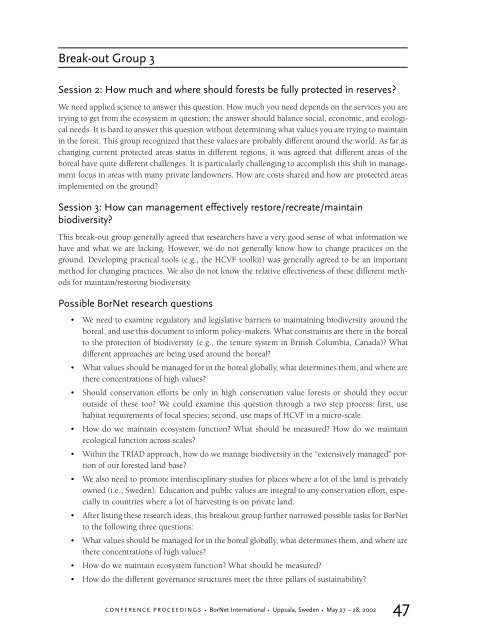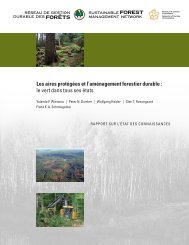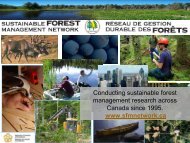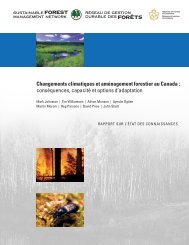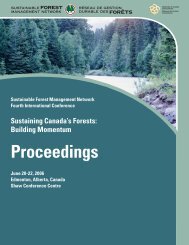Conference Proceedings - Sustainable Forest Management Network ...
Conference Proceedings - Sustainable Forest Management Network ...
Conference Proceedings - Sustainable Forest Management Network ...
You also want an ePaper? Increase the reach of your titles
YUMPU automatically turns print PDFs into web optimized ePapers that Google loves.
Break-out Group 3<br />
Session 2: How much and where should forests be fully protected in reserves?<br />
We need applied science to answer this question. How much you need depends on the services you are<br />
trying to get from the ecosystem in question; the answer should balance social, economic, and ecological<br />
needs. It is hard to answer this question without determining what values you are trying to maintain<br />
in the forest. This group recognized that these values are probably different around the world. As far as<br />
changing current protected areas status in different regions, it was agreed that different areas of the<br />
boreal have quite different challenges. It is particularly challenging to accomplish this shift in management<br />
focus in areas with many private landowners. How are costs shared and how are protected areas<br />
implemented on the ground?<br />
Session 3: How can management effectively restore/recreate/maintain<br />
biodiversity?<br />
This break-out group generally agreed that researchers have a very good sense of what information we<br />
have and what we are lacking. However, we do not generally know how to change practices on the<br />
ground. Developing practical tools (e.g., the HCVF toolkit) was generally agreed to be an important<br />
method for changing practices. We also do not know the relative effectiveness of these different methods<br />
for maintain/restoring biodiversity.<br />
Possible BorNet research questions<br />
• We need to examine regulatory and legislative barriers to maintaining biodiversity around the<br />
boreal, and use this document to inform policy-makers. What constraints are there in the boreal<br />
to the protection of biodiversity (e.g., the tenure system in British Columbia, Canada)? What<br />
different approaches are being used around the boreal?<br />
• What values should be managed for in the boreal globally, what determines them, and where are<br />
there concentrations of high values?<br />
• Should conservation efforts be only in high conservation value forests or should they occur<br />
outside of these too? We could examine this question through a two step process: first, use<br />
habitat requirements of focal species; second, use maps of HCVF in a micro-scale.<br />
• How do we maintain ecosystem function? What should be measured? How do we maintain<br />
ecological function across scales?<br />
• Within the TRIAD approach, how do we manage biodiversity in the “extensively managed” portion<br />
of our forested land base?<br />
• We also need to promote interdisciplinary studies for places where a lot of the land is privately<br />
owned (i.e., Sweden). Education and public values are integral to any conservation effort, especially<br />
in countries where a lot of harvesting is on private land.<br />
• After listing these research ideas, this breakout group further narrowed possible tasks for BorNet<br />
to the following three questions:<br />
• What values should be managed for in the boreal globally, what determines them, and where are<br />
there concentrations of high values?<br />
• How do we maintain ecosystem function? What should be measured?<br />
• How do the different governance structures meet the three pillars of sustainability?<br />
CONFERENCE PROCEEDINGS • BorNet International • Uppsala, Sweden • May 27 – 28, 2002 47


